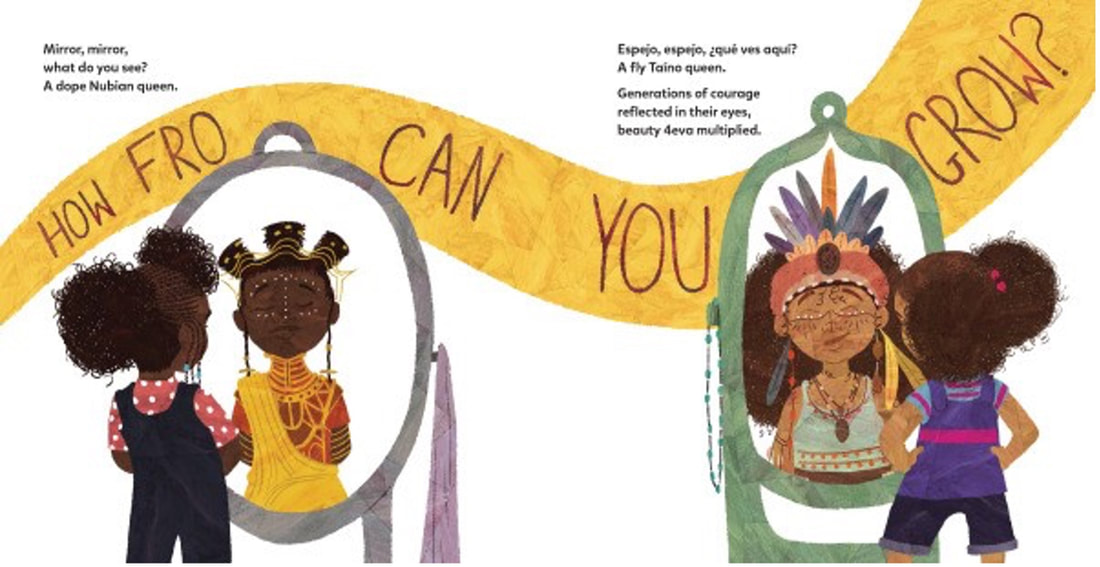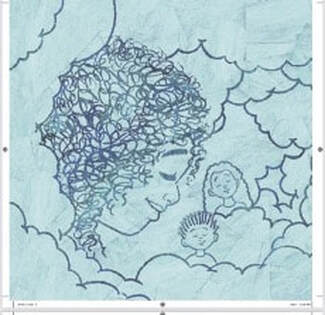|
Las Musas is celebrating the release of NoNieqa Ramos’s sophomore picture book Hair Story, illustrated by Keisha Morris! Lorena Germán, cofounder of the groups #disrupttexts and Multicultural Classroom and author of The Anti-Racist Teacher: Reading Instruction Workbook and Textured Teaching: A Framework for Culturally Sustaining Practices, writes: “This gorgeous book is about more than hair. Hair becomes the vehicle for a conversation about identity, beauty standards, bias, relationships, self-love, and more. Ramos has created a picture book that touches upon identity as it is intertwined with other elements of life, all by celebrating hair types and styles.” This is truth is carried in NoNieqa’s words and Keisha’s art. It’s a beautiful ode to Black and brown children, celebrating their hair and their identity and encouraging “young readers to embrace themselves just the way they are."-- Charlotte Offsay, author of The Big Beach Clean Up and How to Return a Monster. As Preciosa and Rudine embrace their natural hair, readers are invited to do the same. For this blog post, Alexandra Alessandri interviews NoNieqa Ramos about her inspiration and process, but first, here’s a description of this stunning book: With rhythmic, rhyming verse, this picture book follows two girls―one non-Black Puerto Rican, one Black―as they discover the stories their hair can tell. Preciosa has hair that won’t stay straight, won’t be confined. Rudine’s hair resists rollers, flat irons, and rules. Together, the girls play hair salon! They take inspiration from their moms, their neighbors, their ancestors, and cultural icons. They discover that their hair holds roots of the past and threads of the future. With rhythmic, rhyming verse and vibrant collage art, author NoNieqa Ramos and illustrator Keisha Morris follow two girls as they discover the stories hair can tell. Alexandra: When I started reading, I was immediately reminded of Elizabeth Acevedo’s spoken word piece “Hair,” which I’ve used in my classes, and I loved seeing her included in the mural and back matter. It made me wonder what the story’s origins were. What inspired you to write Hair Story? NoNieqa: There are several strands to my inspiration to write Hair Story. I envisioned the story to be a braid intertwining self-love, female friendship, community, cultural icons, and ancestry. As the two friends, Rudine and Preciosa grow and blossom from babies to young children, I imagined their relationship with their hair evolving. In the beginning, both girls are celebrated by their grandmothers. Preciosa and Rudine are perfection. As their hair grows, so does the complexity of the story. Preciosa’s grandmother uses the fraught term “pelo malo” to describe Preciosa’s thick coarse hair. Rudine learns that maintaining smooth straight hair is a long and taxing process. But when they play with their hair on their own terms, they revel in their natural beauty and ancestral roots. Then they witness their mothers doing each other’s hair and begin to understand the healing and magic of self-care rituals. The hair story evolves as the girls comes to enlightenment about how complex and how beautiful it is to be a person-of-color. Alexandra: Can you take us a little into your writing process and book journey? How did you go from idea to book? What did you feel was the hardest part? The easiest? How did it compare to writing Your Mama, which just released earlier this year, or Beauty Woke, which releases in 2022? NoNieqa: I initially pitched Hair Story to my editor Carol Hinz as a spare picture book with phrases like “pelo flow” encapsulated in the illustrations, but she encouraged me to dig deeper. Developing the verse with Carol brought forth the narrative of friendship and love between the girls and between the moms. The easiest parts were creating the clap back to the term “pelo malo” with “pelo grow” “pelo-city” and “how fro can you gro?”. The hardest part was writing the back matter. I had never done it before. I did enjoy the research, but I struggled with making each section thematically-relevant, engaging, accurate, and concise. I mean, it’s hard to do justice to icons like Sandra Cisneros in one paragraph! What all three stories have in common is deep roots in family and community. Strong powerful female figures are central in all three as well. Your Mama was the quickest write of the three and pure joy. In Beauty Woke, I had the challenge of using Sleeping Beauty as a vehicle to talk about a child’s first confrontations with racism. My goal was to weave an anthem and a spell for healing into a narrative arc. Writing Hair Story was much like braiding a squirmy child’s hair. I had to work hard to make sure the part in the middle was even and precise in order for me to do justice to each girl’s story. Alexandra: I love this! Both Your Mama and Hair Story are masterful, and I can’t wait for Beauty Woke! In a recent blog post on SLJ, “What’s Your Hair Story? Guest Post by NoNieqa Ramos and Friends” you mention that Preciosa and Rudine’s names were inspired by “Marc Antony’s anthem to the beauty of Puerto Rico” and Dr. Rudine Sims Bishop respectively, and I loved this. I did immediately think about Dr. Rudine Sims Bishop with Rudine’s name, but I didn’t make the connection with Preciosa. Can you tell us a little more about this decision? Did you know from the very beginning that these were going to be their names? Why are these two particularly important to you and what do you wish to convey about the characters with their names? NoNieqa: Preciosa’s name is based on the song “Preciosa” composed by Rafael Hernandez, born in the town of Aguadilla, Puerto Rico. Singer Marc Antony’s rendition of “Preciosa” is often blasted in our house. The song Preciosa expresses feelings of love and connection to Puerto Rico. It is considered one of the unofficial National Anthems of Puerto Rico. The song includes a celebration of Puerto Ricans’ Spanish, African and Taíno roots. I knew Preciosa’s name early in the writing process. I wanted to leave no doubt that despite any challenges Preciosa might experience such as antiquated and racist notions of what “good hair” is, Preciosa is precious, her cultural roots are beautiful, dark, and deep, and she loves being a Boricua. It took me longer to figure out Rudine’s name. When I realized that my entire story embodies Dr. Rudine Sim Bishop’s “windows and mirrors,” the answer became clear. Alexandra: I’m such a huge fan of your poetry! You have some gorgeous imagery and language in Hair Story, like “baby’s crown/ lush, wild, beautiful brown” and “pointless/ like trying to straighten out/ the ocean,” and such wonderful rhythm and rhyme. I loved that, like Your Mama, this story is written in verse, and it begs to be read aloud. What made you choose verse to structure Hair Story? What was most challenging about this structure? What was the most freeing? Such a huge compliment coming from you, Alexandra! We are great admirers of yours works FELIZ NEW YEAR, AVA GABRIELA! and ISABEL AND HER COLORES GO TO SCHOOL in our home. By writing verse in HAIR STORY, I felt I could capture the miracle, blessing, and exultation of these babies of color being born. I could embody voice even though neither girl speaks directly in the story. I thought verse could depict the complexity of the experience we have in our own skin, our bodies, and how we navigate the world. What was most challenging was using spare language to portray the challenges BIPOC people can experience with hair while making sure I centered joy. What was most freeing was the emotional current verse brings! I envision writing a novel-in-verse in my future. Alexandra: Oh, I’d love to read more verse from you! And I loved the hair puns sprinkled in the illustrations, like “pelo-grow” and “How fro can you grow.” At what stage did you write these into the manuscript? NoNieqa: I wrote them first before the verse! They were my response or clap back to the term “pelo malo.” I wanted kids to feel the energy and power emanating from their crowns when they heard those phrases. Alexandra: And they’re placement in the illustrations is perfect. Speaking of the illustrator, Keisha Morris’ collage art is stunning. What were your first thoughts when you saw her work for Hair Story? Were there any surprises? What are your favorite pages or spreads? NoNieqa: A reviewer commented that Keisha’s jovial color palette and joyful illustrations radiate happiness, and I couldn't agree more. A beautiful surprise were the pages in the beginning of the book before the story starts. The depiction of the girls and their mamas in the sky are mediations of love. One of my favorite spreads are the pages I call “The Welcomings,” when the girls are born and celebrated by their grandmothers. Alexandra: Those were some of my favorites, too. There’s so much love radiating in these pages. Can you share what’s next for you or what you’re working on now? NoNieqa: I am still working on revising my young adult dystopian novel, and I’ll be announcing some new picture book projects in the upcoming months!! Alexandra: Oh, I can’t wait to hear your news! Last question: If you could give an aspiring author one piece of advice, what would it be? NoNieqa: The same I always give! My advice would be to work on investing in community with as much passion as your craft. Community is essential for professional growth and marketing, mental health, and social justice. Your community is your sounding board, your check yo self before you wreck yo self, your squad, your A Team. Alexandra: This is such important advice, and one that I think often gets overlooked. Thank you so much for chatting with me about Hair Story, NoNieqa! I can’t wait for readers young and old to discover this beautiful and important story. Buy Hair Story today!
0 Comments
Leave a Reply. |
Las Musas SpeakWelcome to our blog! Archives
July 2024
Categories
All
|











 RSS Feed
RSS Feed